A while ago I shared a blog post about Picquot Ware. In my original post I discussed the ‘lucky find’ my husband and I had when we bought some pieces of Picquot Ware at a carboot sale last summer. I also shared some progress on polishing up the pots and how I planned to keep them in tip-top condition. Well, since this blog post was published, I’ve been lucky enough receive countless comments on the article from people who still own and use their Picquot Ware.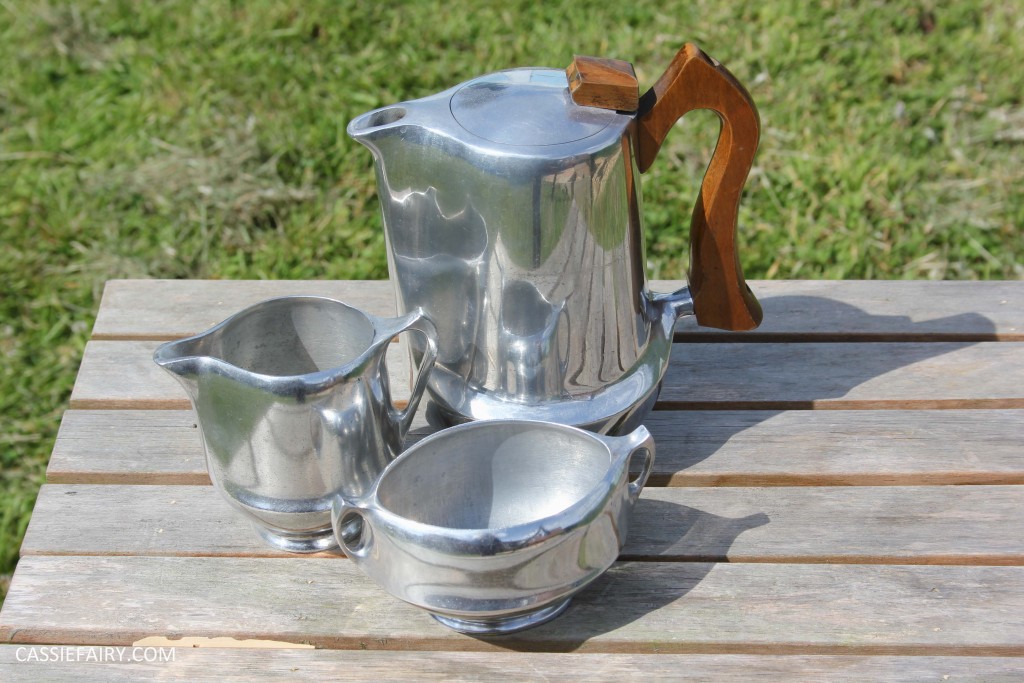 It seems like my little blog post sparked an outpouring of stories, memories, cleaning tips and advice from fans of the brand and I’m delighted with every single comment I read. It’s wonderful to learn about the origins of the company, the people who worked there, the cost of the products ‘back in the day’ and to hear that pieces of Picquot Ware are still going strong in households up and down the country. I look forward to opening up my comments section and seeing what new information has been shared – there’s quite a little ‘community’ of us Picquot Ware fans over on the original post now!
It seems like my little blog post sparked an outpouring of stories, memories, cleaning tips and advice from fans of the brand and I’m delighted with every single comment I read. It’s wonderful to learn about the origins of the company, the people who worked there, the cost of the products ‘back in the day’ and to hear that pieces of Picquot Ware are still going strong in households up and down the country. I look forward to opening up my comments section and seeing what new information has been shared – there’s quite a little ‘community’ of us Picquot Ware fans over on the original post now!
My own Picquot Ware set – before and after polishing
Last week, one of the people I’d been talking to via the Picquot Ware blog post comments section, Lesley, got in touch with me via email with some amazing news. A Picquot Ware instruction leaflet and guarantee had been discovered amongst the teaset that Lesley had inherited. I fired an email back and asked if it would be possible to share this information on the blog so that the whole ‘community’ could benefit from it. Lesley very kindly scanned the documents and forwarded them to me, with permission to share it with you all today. So here’s what we’ve all been waiting for – the original Picquot Ware guarantee, teaset information and cleaning instructions.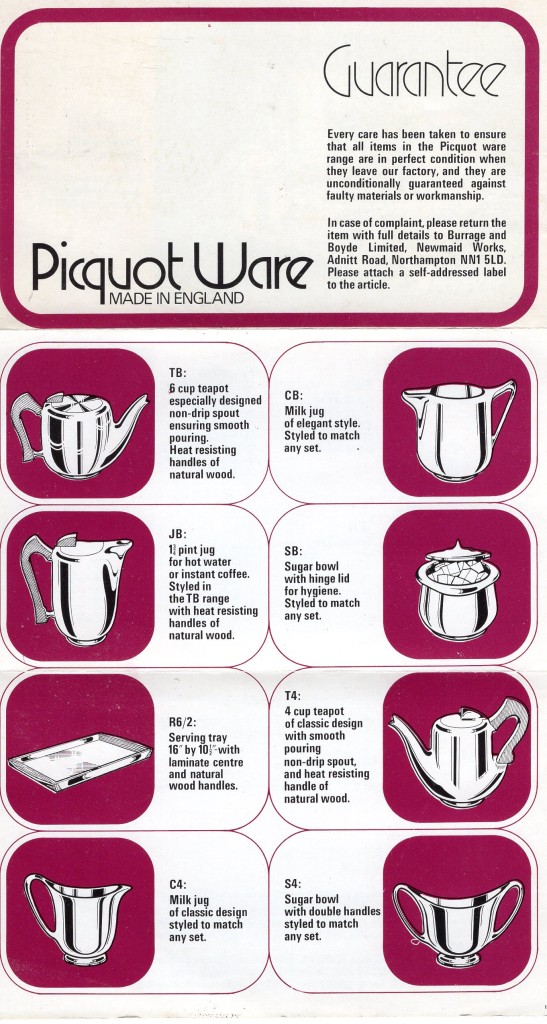 No longer will we need to second-guess how to care for our Picquot Ware – it’s all there in black and white on the cleaning instructions leaflet! I wonder whether this address is still correct for the manufacturers? I’m sure there are a lot of people out there who would love to know how to get in touch with the makers so please do get in touch if you know anything more about this.
No longer will we need to second-guess how to care for our Picquot Ware – it’s all there in black and white on the cleaning instructions leaflet! I wonder whether this address is still correct for the manufacturers? I’m sure there are a lot of people out there who would love to know how to get in touch with the makers so please do get in touch if you know anything more about this. 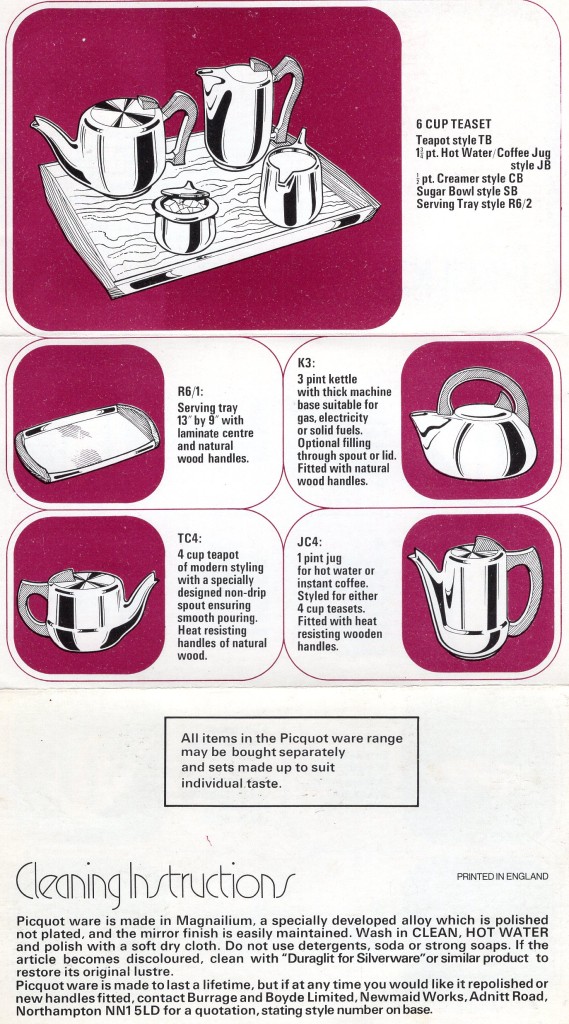 Please do leave a comment below if you too own a set of Picquot Ware and let us know how you use it, clean it and when you first got it – I’d love to hear your stories and I’m sure that everyone else would be interested to hear the history of your own teaset too.
Please do leave a comment below if you too own a set of Picquot Ware and let us know how you use it, clean it and when you first got it – I’d love to hear your stories and I’m sure that everyone else would be interested to hear the history of your own teaset too.










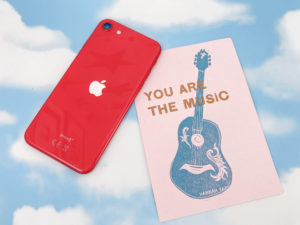
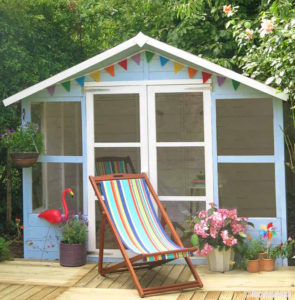

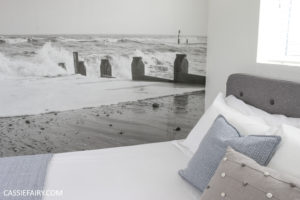
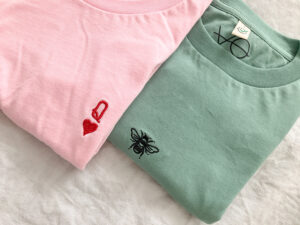






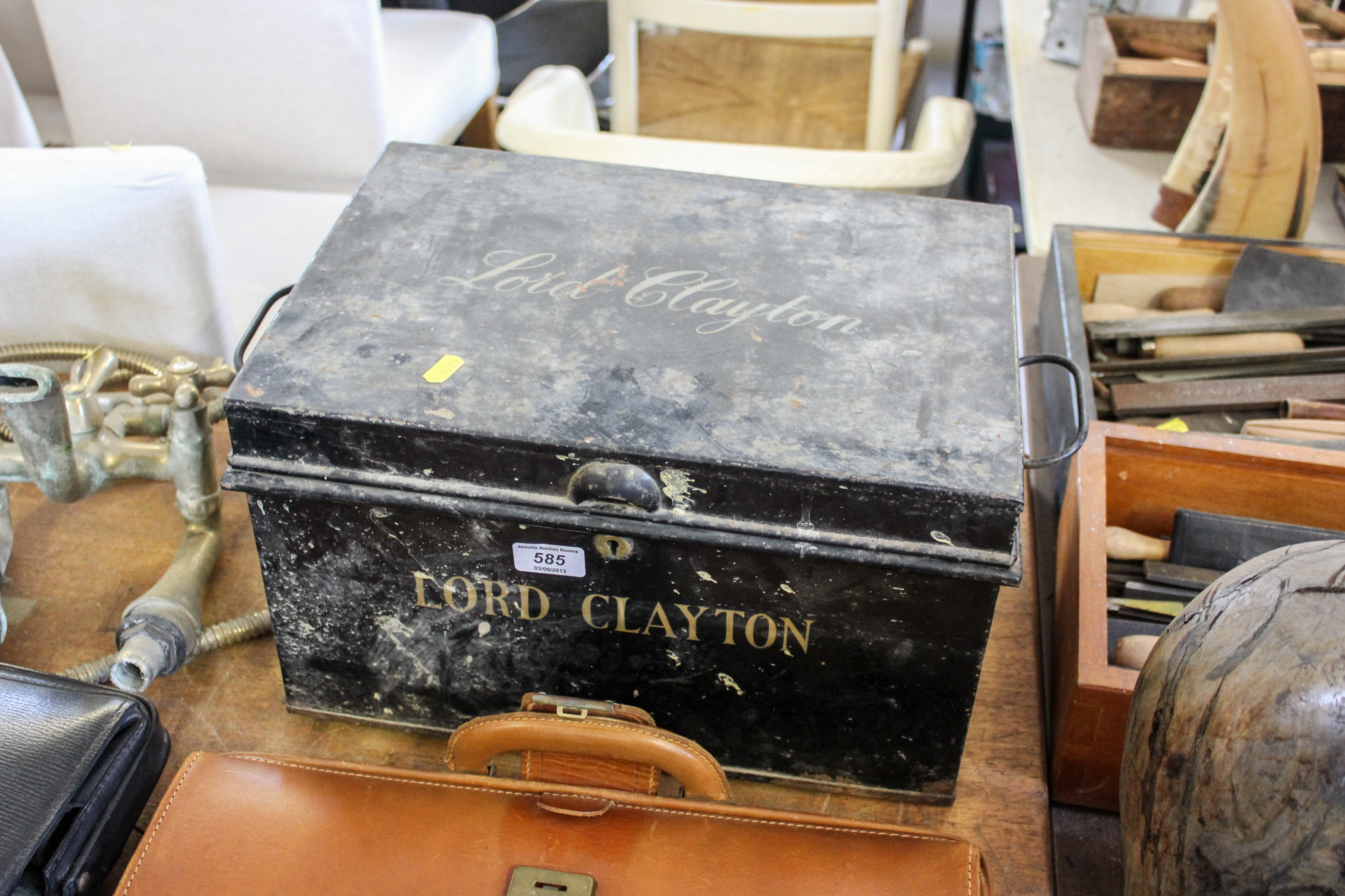

119 Responses
Good Morning from Canada,
I have the wonderful K3 kettle and we use it almost every day. We live in the country and have hard water.
How can I descale the inside of my kettle without damaging it.
Thank you in advance for your help
Gitta
Hi Philip, our readers are located all around the world so there may be someone reading this article who wishes to add your Picquot Ware to their collection! 🙂
Ah, sorry I have just realised that you’re in the US! And I’m in Scotland. Sorry, my mistake. Philip Alvy
Hello, I happened on your blog completely by accident (I was looking up magnalium, of which Picqot Ware is made), and was wondering if any of your enthusiast correspondents would be interested in some Picqot Ware that I have, namely a teapot, coffee pot, cream jug and lidded sugar bowl? They are brand new, unused still in their protective wrappers and boxes. The tea and coffee pots have the original tie on labels – and cleaning instructions inside! Let me know! Best regards, Philip Alvy
Hi Ben, wow I’ve never seen a white K3 kettle before, that’s exciting! Maybe someone here in the comments will have seen one before and can help you with how the finish was achieved? 🙂
Cassie, we’ve just picked up a white K3 kettle. I can’t find any other examples of this version or information on how the white ‘soft sheen’ finish was achieved. I wonder if anyone knows anything about it?
Sure thing Carol, I’m happy to be a go-between and pass your email on to Emi T if they get in touch with me via these comments to say that’s okay. I hope you’ll be able to find a solution to repair your teapot 🙂
Emi T, you may be sent just for me! I looked at this website a year ago, but lost heart regarding being able to repair the handle on my kettle.
During the Covid era, I sat out on my deck and commented on the wonderful smell of wood until I realized it was my Picquot kettle that I had too-long left on the heat. Both the filial and handle are damaged exactly as yours was. The metal part of the kettle was, and remains. in perfect condition. If I give Cassie permission to share my e-mail, assuming she can see it, or if I’m allowed to post a phone number, I’d love to be in touch with you and see if you can help me with the repair. I’m in Berkeley.
I thought the handle was ash, but Sycamore or Black Walnut are good tips.
This will start me looking for a woodworker in the area again, but I would love to talk about this with you should you be game.
Carol West
Thanks very much for sharing this information on how you made new handles and finials Emi, that’s really helpful and it’s so interesting to hear what you’ve done! 🙂
Thanks, Cassie, for curating this information on Picquot ware—-what a wonderful resource! I’ve so enjoyed reading everyone’s stories. I’ve recently been collecting Picquot ware and a few full sets, including K3 kettles, some from relatives in Scotland. Some of the sets have needed a little TLC so I’ve been working with my dad to restore them. One of the kettles had a badly burned handle and finial, and a few teapots had damaged handles. I thought I’d share in case it might be helpful. For the kettle, we unscrewed the handle and finial and initially tried sanding down the burned edges that were in contact with the kettle. Unfortunately, the burned parts were quite sizable so this would have altered the handle and finial a lot. Consequently, we changed gears and opted to create a new handle and finial. My dad is a woodworking hobbyist so it seemed like a fun project. We didn’t have UK sycamore readily available (we’re in California) so we opted for black walnut, which is another hard wood. My dad cut out the handle and finial using a jigsaw, modeling after the original. He then used multiple grades of sandpaper to refine and create a very smooth surface. Drilling holes in the handle and finial to fit them to the kettle was the hardest part, because they need to align just right— a few iterations there! We ended up replacing the old screws with new stainless steel ones that we filed to get the fit just right. We’re currently deciding if we want to apply a stain or just finish with Danish oil, because the black walnut has a beautiful grain. The handle isn’t an exact carbon copy of the original, but it’s a very good replacement and quite beautiful, I think. We’re next working on the teapots and have some good mock-ups of handles.
Hi Catherine, So great to hear that you’ve grown your collection! I’d be interested to know if anyone knows of a refurbishment service too, so hopefully someone will reply to your comment if they do 🙂
My late Sister in law gave me a Piquot Ware kettle some years ago as I fell in love with it. The handle isn’t safe enough to use, and I didn’t ‘bother’ to see if there was anywhere to have it fixed as I honestly thought it was ‘very’ old and unlikely to have anywhere to send it.
I then bought a coffee/water pot in a second hand shop around 8 years ago which was just gorgeous – and I only really bought it because it matched the kettle, and it’s beautiful! Not really to use. However, I recently bought a 5 piece tea set, and I use the teapot every day. I fully intend to use the whole set, but I’m so disappointed in myself that I didn’t look to have the kettle refurbished 12ish years ago.
If anyone knows where I might be able to have my kettle repaired/refurbished, I’d be very grateful and interested to know.
I’m pleased to have found my Piquot Ware People!
Hi Phoebe, there’s an image of the Picquot Ware paperwork in this blog post, which shows that TB is the product code for the teapot and JB is the hot water jug/coffee pot – you can see the codes for the other items from the range in this image too – hope this helps 🙂
Hi have a teapot, water or coffee pot and milk jug, along with Picquot ware made in England tea pot is stamped TB and coffee pot is JB can you please enlighten me about what they mean, many thanks
That’s wonderful news Jennifer, what a bargain! 🙂
I just purchased a water jug to match my T4 teapot ion a local charity shop for $5.00 AUS (about 2pounds 70pence GBP) what a find!! I am now looking at your blog for cleaning instructions as it is a bit scuffed . Thank you Cassie for all the wonderful information on your blog
That’s wonderful Sue, I’m so pleased you were able to find some Picquot Ware at an estate sale and it’s great that you will get lots of use out of the pieces 🙂
I have the teapot, from my mother, who used it all the time. She had the coffee pot but I haven’t been able to find it. I was at a estate sale and found the coffee pot, another tea pot slightly different than mine and creamer sugar bowl with the tray! I scooped them all up for about $60, so thrilled! The were polished and lightly used. Since I drink tea they will get usedand I think of mom every time I use it.
Hi Geoff, oh dear, I don’t know where to source handles myself but hopefully someone will have the answer – it would be really useful to know where to find replacement handles for Picquot Ware.
Hi everyone ! I have a newmaid cast ware 3k kettle with original handles and hey presto tonight the one for the lid just sort of crumbled off between my fingers ☹️ both the lid handle and the main carrying one are sort of chared black at the base (if you know what I mean)
So I would prefer to replace both.
Could anyone please point me in the direction of somewhere that I might be able to obtain said handles ?
Regards
Geoff
How wonderful Michelle, that’s great news! 🙂
Hi I have just acquired a Tea Pot Coffee Pot/Hot Water , Sugar Bowl and Milk Jug as well as the kettle. I had no idea how fashionable they are now.
Hi Michelle, personally I haven’t needed to replace any handles or finials so I’m not sure – perhaps someone will see your comment and offer a solution? You could read through the comments section on my other Picquot Ware blog posts as you might find some info from others there. Good luck and please let me know if you find a replacement 🙂
Hi Cassie,
I have a Picquot teapot and the Sycamore finial on the lid has worn away on the inside (where it is screwed) and falls from the lid. Any ideas where I could get a replacement?
Thanks
Michelle Taylor
Let me kno if you want to sell it, please
Let me kno if you want to sell it, please
Hi Jules. Thank you for that really informative post. I am trying to restore my parent’s set but the handle and knob may be passed it. I’m going to attempt to sand down but interested to know what colour you stained the wood in the end and what varnish you used. Thank you.
Thanks Lesley 😀 Ooh I’ve never seen a Picquot Ware griddle – how interesting, I will have to do some research!
I have a Picquot Ware Griddle, has been used many times during our 42 years of marriage.
Was given as wedding gifts along with tea pot, water jug, creamer and sugar with lid, which have also been well used.
So pleased to have this site to obtain information on how to keep it well maintained. Thank you for this..
Thanks very much for this advice Jules 🙂 Let us know what colour stain you decide on for the handle!
I am in the process refurbishing a K3 kettle which I unfortunately left on the hob a little to long. The handle was burnt at the base and of course now that Piquot Ware Ltd. have ceased trading replacement handles are difficult to find. Do not fear the handles are salvageable – I removed mine from the kettle and stripped them back with graduated grades of sandpaper, removing much of the burnt the burnt base and revarnished. However there is one issue when you strip the handle back, the bare sycamore is light in colour and one has to assume that the base wood is stained darker before being varnished – I am trying to work out what shade of wood-stain was used? Also to note I used a heat resistant gloss varnish – gloss doesn’t look quite right and I would recommend using satin or matt varnish, which I will do once I’ve worked what colour to stain. As others have noted the kettle can repolished – I took mine to a local metal polishers and it came back looking like new. I’d advise not to have the base polished though – it is has a fine concentric circular line ingrained into the base which is there to create some grip – industrial polishing will remove this finish so be careful to instruct the polishers to leave this alone and finish cleaning by hand.
Thanks so much Heather, that’s very kind of you 🙂 It sounds like you have some interesting information there!
Fabulous post, Cassie. My grandmother’s “Peacock” pot was always my favorite.
Please have Max above reach out to me and I will send copies of whatever I have that may answer the buyer’s query.
I pulled out some files I have from about 20 years ago. I believe the letter I have is from the managing director of the Picquot Ware line at the time. (What a gentleman!) I recall he may have mentioned the stamping and production info.
Hi Max, I’m glad to see that you’ve had a reply from Richard 🙂
I’ve just bought an unused Piquot Ware tea-set (teapot, water jug, milk jug, sugar bowl and tray) and the stamping on the bottoms is pretty badly done. The stamping on jug is well off centre and on the teapot you can see that they have had two goes at stamping the text, as the first time it didn’t really work! Therefore I don’t think that bad stamping is an uncommon thing. My jug is labelled “Picquot Ware” and the rest “Newmaid Tableware” so either the set was bought around the time of the naming changeover, or it’s been made up gradually over the years.
VERY URGENT INFO NEEDED
Dear Cassie, I have just found your very informative blog on Picquot Ware and am sure you and/or others might be able to help me. I have just sold a Picquot Ware Teapot on Ebay and the buyer has put into action a complaint saying that the item “doesn’t seem authentic, is not an original piece, isn’t signed and is badly stamped” and is asking for her money back. I have no problem in giving her the money back but am disturbed by her allegations. The lady in question claims that the underside is “not properly stamped” and has sent a screen shot of a similar item also being sold on Ebay. I have searched around Ebay and the internet and have found many examples of what I think is the issue. If I understand it correctly the base markings on older items are heavily engraved and on later items they are stamped. These markings are for the “Picquot Ware” signature and the “Made in England” marking.
Having read several comments by some of your contributors it appears that the company started to have financial issues in their latter years and it occurred to me that they may well have reverted to stamping the details on the base as a cost cutting exercise. The heavy engraving that they had previously done would have been considerably more expensive than stamping.
All of this has come as a shock to my wife and I as the Tea Pot was a wedding gift to us in 1969 from my grandparents who also had a full set of Picquot Ware (originally purchased from Binns of Sunderland).
So are you able to confirm that the Tea Pot markings are genuine? ( I can’t imagine that they wouldn’t be.)
Hope you can respond quickly as I need to get this matter resolved before the lady gives me negative feedback which is every Ebayer’s nemesis.
With regard to the handles and the small knobs on the lid. The handles can be seen on Ebay in the UK. There is a small copper plug and underneath that is a screw that will let you remove the handle or knob. The wood is sycamore and a good woodworker should be able to fashion a replacement. I’m not sure if sycamore is available in Australia due to the strict import laws, but I’m sure there would be a good local alternative.
Anyone know how to remove the handles for restoration? Are they plugged with a screw below? I’d like to date each item I have but can find little information.
Hi Jan, thanks for getting in touch. That’s such a shame about your teapot knob. I don’t know where to find a new one but perhaps someone else will reply to your comment if they can help 🙂
Hello, Looking for some help. I love our T6 teapot and use it everyday, well unfortunately the wooden knob has disintegrated. I live in Victoria Australia, is there anywhere in the world to get a replacement knob???? I am just devastated. Thanks for any assistance.
Good afternoon from Detroit. Glad to find your site. I have three teapots and two have Picquot Ware written into the bottom, the other one is stamped. Does this tell the age of the teapots? One year when we were home I took my teapot and sent it to England and had it polished. The had it back to me before I came back to Detroit and my Mum was sorry she didn’t bring hers. Any information would be appreciated, I don’t remember when I got mine. Regards.
I should have said. Go onto Google and enter ‘metal polishers near me’. That should set you right. As some alloys melt, the polisher may be worried about polishing out the deeeper scratches. This won’t happen with Piquot Ware. It can be polished fairly heavily.
For refurbishing Piquotware, as long as the handles are not loose or damaged and it is just the metal needing restored, take it to a professional metal polisher. Will cost you around about £20 per pot. To clean the inside, as finish is not important, a quick clean with a brillo pad works wonders.
In answer to Mary Spence : I haven’t heard of anyone out there with the skills or ability to refurbish Picquotware. Cassie’s blog has lots of posts with advice on how to clean and renovate these items, but if you need to replace a handle on a K3 kettle, for instance, your only hope is to put the word out and hope, and keep checking sites such as eBay and Facebook Marketplace. There’s a couple of little-used Facebook groups for owners of Picquotware, you might perhaps get some information there. If all else fails you may just have to put your old K3 into store and keep your fingers crossed it might be possible later to do whatever needs doing, and go and find another. Good luck.
I have a Picquotware K3 kettle in need of refurbishment. Does anyone know if there is anyone out there who can do this now that the factory has gone?
Someone once said, “the internet never forgets”. That may be true, but it’s becoming difficult to persuade it to remember without paying. Fortunately there are some heroic people who maintain an archive of websites – often only the home pages, but it’s something. This is a link to a saved page from picquot[.]co[.]uk – don’t bother trying to go to that site now – and it gives a lot of information about the history of Picquot Ware and the different product ranges.
https://archive.is/1oRnQ
I think that there’s an assumption that all Picquot Ware is vintage but I remember seeing it new at Glanvilles cookware ahop in Wadebridge, Cornwall, probably around 2005. It was identical in every way to the older items and presumably supplied by the Scottish producer. Their website not only provided the restoration service but sold new items too. I really wished I’d taken screen shots of the site as it gave a pretty comprehensive list of all sizes and shapes that had ever been made…
I have an old teapot and a newer one I brought back from Scotland. I emailed the company to find out if the materials are safe to use. They told me of course they are. WTH the aluminum I’m still nervous to use mine. I did love how it keeps the tea hot. Does anyone know if it is safe to use?
Deborah.
Hi David 🙂 It would be great to find out if there’s another refurbishing company out there – any ideas anyone??
Cassie,
We now have many Picquotware products which we have had refurbished by Robert’s ex factory in Scotland and wonder if any of your readers have found an alternative refurbishing company which could help me. Best David Westbrooke
Hi Cassie and all readers with a Picquot Ware Set. A few days ago I was at an Antique Centre with my husband Mike and eldest grandson Luke, searching for an antique well made sideboard. We found what we were looking for but on the way to the counter I was having a look around and espied a Picquot Tea Set sitting proudly on another piece of furniture. My husband wasn’t keen to get anything else that day but I had saved my ‘hair money’ so was able to pay for it . Because I had the cash we bought the set for less than the asking price. It cost me £45 and I was so pleased with it because it reminded me of my Aunt Joyce and Uncle Peter who had bought one when they were newly weds back in the 50’s. I always admired the style of it and was determined to buy one one day when I married and set up home.Well, 47 years later we now have this lovely tea set. A TB (T6 on the base) Teapot, a JB hot water / Coffee jug, a CB milk jug and an SB sugar bowl with hinged lid. I have washed the set which is in very good condition and shines.Thank you for the info on the instructions that you posted. Regards, Pam.
Thanks for your comment Esther, it’s great that Picquot Ware can bring back memories isn’t it?
My mum and grandma have quite a lot of these bits.
The tray, tea pot, kettle, jug, hinged sugar bowl and water pot.
The close of the lid always brings back childhood memories of tea being made.
Glad to hear that your teapot is still going strong Sue! 🙂
My Mum gave me her teapot over 20 years ago. We had it completely cleaned out and repolished by the firm in Scotland (expensive mind you). It came back good as new and we’ve been using it ever since. Thanks for your posting and the cleaning instructions. Great to have but sorry to hear that the firm in Scotland have now closed.
I am a Canadian and received the tea set with tray as a wedding gift in 1974 from my aunt and uncle in Scotland. I have only used the tea pot once or twice for fear of staining it. The set is on display in my dining room. When I pass by it I often think of my aunt, uncle and parents – all born in Scotland. My fathers family immigrated to Canada in 1929. My mother was a war bride who my dad met in 1942 while on leave in Scotland. So the set is more of a keepsake than a functional piece. I only dust it with a dry cloth. Needless to say it still looks new.
Wow, a never-used set? That’s exciting Vicki! Hope you enjoy using it 🙂
Really glad I have found this blog .
Clearing parents house recently and I’ve been thinking of selling their lovely , immaculate , never used set . Not now !!
I may even use the teapot
Oh no, that’s such a shame Beth – fingers crossed someone can help you via these comments 🙂
hello – can anyone help, my beautiful picquot stove top kettle was left on by mistake and now the handle is scorched and falling off. does anyone know where i can get it fixed? thank you so much in advance!
What a great find Gina! Hopefully someone here will be able to help you with tips for cleaning the grate 🙂
I just found the teapot at a Goodwill store! I thought it was cute; then i discovered what it was! I need to do some heavy cleaning on it. Does anyone have any hints and tips for cleaning the grate on the inside as well as the neck? I don’t want to use anything abrasive if it will only do damage…
Oh nooo Simon, that’s such a shame – and after all those years too! It’s amazing how long Picquot Ware lasts isn’t it? 🙂
Well what a sad day, the oldest of my Picquot K3 kettles has died. After a week of wondering why it kept jumping on the Aga hot plate I have found some corrosion on the base. It’s gone porous and allowing water to seep out and creating a pocket of steam between the hot plate and the kettle thereby causing the kettle to jump with a bang.
So number two K3 is being pressed into action. This our newer one that we have had of 37 years, the handle wore out after 20 odd years and we sent it to be refurbished at the factory. At that point we started using my deceased mother’s old K3 which had been previously refurbished in her ownership. This is the one that has finally expired and it must be at least 60 years old.
Unfortunately I cannot find anywhere that now refurbishes these wonderful kettles and now no longer have a spare to fall back on.
I wonder how many gallons of water they hove boiled over all these years.
Regards Simon Price.
These items were sold under the Newmaid name after the war from 1947 to 1951. The Picquot Ware brand name was invented for a trade exhibition in 1951 – “Jean Picquot” seems never to have existed – and continued in use until production at the Northampton foundry in Adnitt Road abruptly ceased in 1979. The company folded on the same day my father, the chief foreman in the foundry, was due to retire, robbing him of his company pension …
Burntwood made heavy-duty aluminium saucepans, and production of them continued for a while. I still have a couple, boxed and unused. There doesn’t seem to be much of a second-hand market for them.
Some Picquot Ware items were made at a foundry in Scotland, which operated for about ten years until the banks foreclosed on the company a few years back.
The story of the later attempt to re-start production is here –
https://cassiefairy.com/2016/04/07/picquot-ware-instructions-guarantee-information/#comment-44066
So the Newmaid items you have are almost certainly from the late 1940s, but the teapot is later – the code on the bottom will give you a rough idea of the date if you look it up in a post I made in 2016 –
https://cassiefairy.com/2015/06/25/1950s-picquot-ware-my-tips-for-polishing-metal/#comment-44019
Thanks for sharing this link Fran, very interesting to read 🙂 Ah I’ve not come across any New Maid pieces yet, how wonderful that you inherited a tea set!
I inherited from my mum the a teapot, coffee/water jug, sugar bowl, milk jug & tray.
These where a wedding anniversary gift in I think 1982. Interesting the teapot is Picquot Ware and the rest is New Maid I’m guessing that mum’s teapot was original Piquot Ware and the rest was manufactured after 1980 when the New Maid trade name was established.
https://www.gracesguide.co.uk/Burrage_and_Boyde
Strangely I grew up in Northampton where it began and now live not far from Burntwood where it ended!
Wow, sounds like you got a bargain there Alison, congrats! 🙂
I inherited the same three pieces you bought. They need a clean, so thank you for the instructions!
refurbing and buying picquot ware, fitz foods, borough market, london
Sounds like an impressive collection Mary! Good idea – get them out so that you can see and use them every day 🙂
Interesting question Andrew, I’d love to know where to get kettles etc restored too, so I’m hoping that someone will be able to give us an answer! 🙂
We’ve had a Picquot Ware kettle for a couple of decades. About 8 years ago I sent ours to be refurbished and a new handle fitted. I had a chat with (I think) Robin Macgregor at Picquot Ware.
I recently looked out the paperwork and I cannot get a reply on any of the old numbers.
Does the online community know anyone who restores K3 kettles and their handles?
Oops. Correcting spelling mistakes. Should of course be Picquot Ware.
My lovely mother-in-law bought us a set in the early 1970s. We were delighted with it and ‘kept it good’. In those days, it definitely was a ‘must have’ item. I have the teapot, water jug, milk and sugar bowl and they are in immaculate condition. They were always kept in a cupboard and not really used. However, over the last month or so, I have been using the teapot. I do love it’s shape and look and it keeps the tea lovely and hot.
I thought I would look up Picquot Wear and found your great site. I’m amazed that so many people also love these beautiful pieces. I’m sorry to say that in those early days, I never appreciated how lovely they are.
Since I have been using the teapot, I have been washing it in warm, mildly soaped water and giving it a rub with a dry dish towel. It is still lovely, bright and shiny.
I will certainly use and look after them from now on but will also have them out and on display instead of hidden away in a cupboard.
I will,also keep an eye on your site for further information and updates on looking after my Piquot Wear.
I still use my grandmother’s Picquot teapot, and it’s time to clean the tannin-coated inside… any hints (apart from scrubbing until your arm drops off)?
I found your website while looking for information on Picquot Ware. I picked up a 6 cup teapot & a coffee/hot water pot today in a local charity shop for £3 each. I spotted them across the room & made a beeline for them! Not come across them before but I was attracted to their shape, so tactile, I admit I was stroking them as I took them to the till! I’m going to keep a look out for the rest of the set now. Thanks for the interesting information on your website.
Having done some searching, the consensus seems to be that you’re safe from ingesting more than a miniscule amount of aluminium from using the kettle, hot water jug, milk jug, or sugar bowl.
With the teapot it’s best not to clean the inside too much, especially not with anything abrasive or with any acidic liquid. Anna’s grandmother’s advice never to clean the inside of a teapot is probably quite sound.
Using aluminium saucepans is more likely to pose a problem of metal leaching into the saucepan’s contents especially if those contents are acidic. And if you wrap food in aluminium foil for cooking that probably carries an equally high risk of metallic contamination. By contrast using a kettle or teapot is extremely low-risk.
Interesting point Martin, I wonder if anyone can help? I know that Picquot Ware isn’t just made from aluminium, I think it’s a mix of materials..?
Hi there – I just purchased a beautiful K3 kettle and am very proud of it, but now a friend reminds me that aluminium has gotten quite a bad health reputation lately (linked to Alzheimers and cancer). As most aluminium cookware is cheap and awful, folks would pro probably just avoid it, but with Picquotware, there is obviously an aesthetic reason to cling on. Like everything these days, you find plenty of sources for either side of the argument (unhealthy vs. unharmful) but I was wondering if anybody here might have gotten to the bottom of it? Thanks, Martin
See Cassie’s original post about cleaning Picquot Ware –
https://cassiefairy.com/2015/06/25/1950s-picquot-ware-my-tips-for-polishing-metal
Me again, Anna, I forgot to mention the classy tray!
Hello England and all other Picquot lovers over the world. My name is Anna, I come from Katwijk, the Netherlands and I treated myself today with this beautiful teaset, of which I cannot show the picture ☹️, but it is beautiful. It’s a set with teapot, water pot, sugar- and milk bowl. Bought it today at an antiquemarket in The Hague. I paid £ 120,- the man started with £ 150,-. Now I understand a little bit too much, but, again, I LOVE IT!
It is very clean on the inside, and I also had a grandmother who told us NEVER to clean the inside of a teapot.
Having set this, I am still not sure what’s the best way to clean the outside. I saw metal polish, but also somebody said to only use a dry cloth (not sure if this is the right word). Anyway, what is the best way to make my beautiful Picquot set shiny again?
Kind regards,
Anna
Hi Kathy, it’s so interesting to hear that you got your kettle refurbished at the factory, I bet they did a great job! Ooh yes, let us know if you get any response to your email, I bet there are lots of people who would love to get their own Picquot Ware professionally refurbished if it were possible 🙂
Urgent …there is a small tea pot on UK eBay
Hi, like you Kathy I am consumed with the search for a coffee percolator. I had several pieces refurbished in Scotland, and talked with Robert quite often. He told me that the mould for the small pot had been broken and there could be no more. I haven’t seen a small one on line for a while but they do come up now and then. There are many sites that sell Picquot Wear mind you some are just copies of what can be found else where. I hope that you are fortunate in your search.
Hi Cassie and everyone, I’m so glad to have found this blog. I have a full set with tray, a kettle (used daily) and a second teapot, also used daily. A few years ago after the kettle was almost destroyed by a workman leaving it to boil dry on the gas stove, I had the kettle refurbished by Robert at the Scottish factory and they did a very good job, replacing the burnt wooden handles, relining the inside of the kettle and repolishing the exterior.
My daily-use teapot has just given up the ghost – the interior is in a terrible state, the strainer inside the spout has fallen out and the wooden handle is peeling, though the wood is ok. I’m so upset to hear that the factory in Scotland has gone bust – I was planning to send the teapot to Robert for refurbishment this week! I think I still have his email address so I will try contacting him. Otherwise I will be on the lookout for another 4-cup teapot, they are perfect pourers and make a great cuppa.
I’m in Melbourne, Australia and have bought all my Piquot Ware locally over the past 25 years – harder to find now than it used to be. Now that I’ve seen the coffee percolator I’m consumed with envy and will be on the lookout….
Cheers, Kathy
That’s great news, thanks Helen. Glad to hear that your Picquot teapot is still in use and I’m so pleased you managed to find my site again! We’re really lucky that a fellow Picquot Ware fan still had the instruction/paperwork and that I could share it for everyone to read 🙂
Just to say – Thank you – I have rediscovered you just in time ! Not being a computer whizzkid – I was at my wits end trying to find out to clean my Picquot Teapot. Handed on to me in the 80’s by my Mum, it has been well loved, but not looked after very well. By chance I found your website several years ago and managed to answer all my questions, and then could not remember the details of your site. I had managed to ‘serve’ my teapot in all ways except one – My Mother used to clean the inside of the spout with 3 pipe cleaners twisted together. But, after several more years I could not find a fresh source for them – until I looked on Amazon last week. And today, quite by chance I found your website again, so am now in the delightful position of learning to care for my picquot correctly ! All over again ! And She Looks just beautiful….. Thank you Cassie, sincerely Helen
My friend in Canada gave me my set – her husband says to clean the inside of the teapot by boiling half and half white vinegar and water in it on top of the stove. Works like a charm!
I now have a kettle ( given to me as a Christmas present – thank you all!) and am trying to find out if it is safe to use softened or filtered water in it. Otherwise I shall be filling it from the outside tap!
Re handles yes there is an answer in my pervious comment. After rubbing down with glass paper make sure that the wood is really dry and dust free then varnish with marine quality varnish. Works for me.
Glad to hear that the blog has helped Alan! Thanks for sharing your Tee Cut idea, I imagine the shine would be much better after using that 🙂
Ooh I wonder what can be done about the varnish coming off the wood – has anyone restored their handles and if so how did you do it? 🙂
I’ve found both your comments Eleanor – one was on this post and the other appeared on the original post https://cassiefairy.com/2015/06/25/1950s-picquot-ware-my-tips-for-polishing-metal/
Thanks very much for taking the time to share your story… twice! 🙂
While polishing my pots I was thinking ….if you bought a silver tea pot and used it you would keep it polished even though silver dealers say we should not over polish silver. Why do folk let Picquot Wear go dull? People just haven’t valued them enough. I don’t think you can over polish Picquot Wear it’s almost indestructible. I have just bought a set of Stellar saucepans (other pans are available!) the cleaning instructions they give on line are useful…worth a look.
I never knew that! Picquot Ware is a famous ‘prop’ now too! 🙂
Sorry you had to rewrite your comment Eleanor – I can see both comments at this end so I’ll try to repost to make sure that they are seen by all 🙂
I agree with your grandmother Elizabeth! I’ve never tried the bicarbonate of soda trick – will give it a go next time I want to clean my flask 🙂
Coke is a great cleaning tip, thanks Eleanor 🙂
Thanks. I think your grand mother was a wise lady! I’ll try the Bi carb….might just work. By the way Coke Cola helps clean the water jugs but it is not perfect.
My grandmother always said let the teapot discolour on the inside for the best tea! I have never tried to clean the inside and the tea still tastes good after 46 years. I wonder if bicarbonate of soda would clean the inside because you use it to remove tea/coffee/etc stains from thermos flasks successfully?
I wrote some comments yesterday but on checking only my PS has appeared on your site. So I’m rewriting my story. I was with my mother in1969 when she bought a Picquot Wear tea set…tea pot, hot water jug, lidded sugar bowl and milk jug plus the tray. The shop assistant said that they would last a lifetime. By 1985 both my parents had died no when I cleared the house I let the tea set go,. However my Aunt wanted the sugar bowl and jug. When she eventually passed away I was sensible enough to keep the small tea pot, small water jug and of course the sugar bowl and milk jug. I just tucked them away and didn’t use them. In, I think 1999, I bought a brand new T6 tea pot from eBay. Then another small tea pot. These made mine look dull now ar that time, early 2000’s you could have the items refurbished….for a price…..so I did just that. While talking with the boss of the business he told me that he had tried to get the workers to take over the refurbishment business but that they weren’t interested. He also told me that I was lucky to have the small tea pots as the mould had been broaken and there could be no more. I just love my Picquot Wear. I have two sets, one needing a good polish the other only comes out on high days and holidays!
Cleaning the outside is the easy bit, any suggestions as to cleaning the inside would be great fully received. My recommendation is after use never let the tea sit in the pot, straight after use wash and dry the pot both inside and out. Never leave them wet or even damp. When the handles becomes shabby rub them down carefully with glass paper and revarnish with marine quality varnish. Replacing the wood work requires finding a sympathetic wood worker, but it can be done. Make sure you have a picture of the side handle and top one fitting together when open so that the crafts man can copy the design.
PS to my comments…..Of course we are in good company as Mrs Brown, of “Mrs Brown’s Boys” has the tea pot, a very well used tea pot!
I yave a 6 cup teapot that was a wedding present in 1971 and it is well used though not so much now that there is only two of us but it does get used when we have visitors. The wooden knobs on mine are the thing that really need attention as all the varnish(?) has worn off and now bate wood. Any suggestions for restoring the wooden parts? I will give the cleaning of the netal a go but it is the scratches rather than the shine that is the problem here.
Many thanks for the information in your blog. I have a teapot and water jug which I dug from the back of a cupboard and honestly cant remember where it came from , but know I always loved the design. Mine is not in bad condition but was a little dull so after some reading I first attempted to clean them with tomato sauce! Yes it did work but a long slow job. I then decided to try Car paint restorer ” tee cut” with some good results. This took away the dullness and restored the shine but did show up a few deeper scratches and a few marks almost like water marks. I will continue my quest and hope to find and purchase a sugar bowl and milk jug asap and put it to regular use.
Wow what a find! Congratulations Jim, enjoy your new set of pristine Picquot Ware! 🙂
Hi Margret, good to hear from you & I’m glad that you’re going to clean up and use your Picquot ware set. I completely agree, the design was ahead of its time – I love how they look in my home 🙂 Interesting to learn about the prices on Ebay, it’s amazing how much the price varies, isn’t it??
Re. the renewed manufacture of Picquotware, see the post I made here on April 21st. Yes, by the end things were tough for the man who had tried to keep things going in Scotland. The banks moved in and the last few posts on his website were quite despairing.
I think if you got a complete set of Picquotware, boxed, unused and with all the documentation present and correct then you have had a huge lucky find – not quite a lottery win, but pretty close.
Thank you so much for this information. I have a four piece Tpot Waterpot milk and sugar set inherited from my nana and mother who really never used it. Marked Piquot ware, I remember it pretty much all my life so probably ’50s or early 60’s. I love it but never-seldom use it, since I not a tea person! I very much wish I was because it is so lovely and I think should be used every day.
I am delighted to know more about it. Have been thinking about selling if no family nieces/nephews want it and there seems to be a market. But for the time being I will now find a way to use it (after a good clean! So thanks for the instructions).
Ebay prices at present (1/1/17) between 45 and 80£ ? (I could see no difference in condition on those … interesting).
I think the design is genuinely at least 30 years ahead of its time if not 60. These could be modern and not just because of the retro boom.
You and yr man got a real find … well done.
(I may have to open an eye for the percolator but think it would be a very long shot!)
Thanks again so much and best wishes for enjoying your set and general life and health in 2017
I bought a new K3 kettle a couple of years ago from Everhot cookers – quite apart from looking good it boils faster than anything else I have tried. Largely due to the fact that the base is wide and perfectly flat.
Were you aware that manufacture finally stopped last year? I got the impression it was virtually a one man band by the end.
This summer I saw a Picquot teapot for sale in a local antique shop. When I enquired the owner asked if I was interested in a set he had – it turned out to be a teapot, coffee pot, milk jug, sugar bowl and matching tray. But more amazingly it was all boxed and unused complete with guarantee and the instructions you published above! Apparently it was a duplicated wedding present and had lived in the recipients loft since the 1970s. I can’t remember exactly but I paid less than £100.
So pleased to hear that you still use your Picquot Ware every day Heather:) Oh yes, we are very lucky to have a copy of the original instructions that a fellow Picquot enthusiast sent in – so good to know how to clean the pieces safely. Thanks for getting in touch x
Thank you for this information! My children and I use the exact same sugar and cream set each morning when we make tea in the US. My mother found them at a sale and we just recently turned them over to read the bottom. It is so helpful to know how to care for them!
That’s great news Kay, thanks for letting us know – Duraglit sounds like a great cleaning solution 🙂
Thank you so much for this information. I first got a set as a wedding present in 1973 and had packed it away for years, thinking I’d have to send it away for refurbishment. But the Duraglit – and elbow grease – has done the job.
Hi Cassie
Thank you for your swift reply, it is much appreciated.
Yes, I will have lots of use and wear out of my lovely Picquot set from my lovely Auntie.
I am grateful to you for supplying the website for the handles. I shall go onto this now and see if it says anything about restoring the handles.
Thanks again
Sounds like you have a lovely set of Picquot Ware there Jan, I’m jealous! Glad to hear that you’re still using your Auntie’s collection 🙂 Not sure about the handles, I’ve never tried to do anything with mine – but there’s a bit of a discussion about handles in the comments section of my other Picquot Ware blog post, so you might find an answer there: https://cassiefairy.com/2015/06/25/1950s-picquot-ware-my-tips-for-polishing-metal/
Hi Cassie
It has been very interesting reading your blog about Picquot Ware. I have just inherited from my Auntie in the UK, the tea pot, hot water pot, sugar bowl and milk jug along with the original tray. I have had tea served from this pot at my Auntie’s since I was 15, I am now 64 and live in Australia. You can imagine how thrilled I am, but, the Sycamore handle on the tea pot needs to be restored, as it has lost its beautiful wood shine. I am not sure how to go about restoring the handle and wondered if you had any idea how I should go about this please. I will be off to get the metal polish, although all of the products are in extremely good condition, being that it was used daily for 50 years. But I would like to restore the handles. Any help would be very much appreciated. Kind Regards
Jan
Hi everyone,
I’ve just published a new Picquot Ware blog post with photos of Robyn’s rare coffee percolator – follow this link: https://cassiefairy.com/2016/05/18/picquot-ware-the-coffee-percolator/
Thanks! 🙂
“I wonder whether this address is still correct for the manufacturers? I’m sure there are a lot of people out there who would love to know how to get in touch with the makers”
Cassie, as I said in a comment on the other blog, the Adnitt Road (Northampton) address was the factory where these were made for over thirty years. When Burrage & Boyde closed the factory in 1979 production of some items (saucepans, mostly) was transferred elsewhere for a while. After the Northampton factory burned to the ground in 1987 ownership of the Picquot Ware and Newmaid brands was transferred from company to company, but no-one was seriously interested in resuming production until about 10 years ago, when Picquotware UK set up a small factory in Scotland making and refurbishing Picquot Ware. Until very recently there doesn’t seem to have been enough of a revival of interest in these classic items to make their operations viable (or perhaps it was a case of the owners of Picquotware not being aware of where their customers could be found). For whatever reason, the company encountered financial difficulties a couple of years ago and seems to have been closed down by the bank about the end of 2014. So as far as I know no-one is making these now, nor is anyone able to refurbish them. A great pity, especially as I think there is enough demand to keep a small-scale business going.
The later history is covered briefly in http://www.gracesguide.co.uk/Burrage_and_Boyde